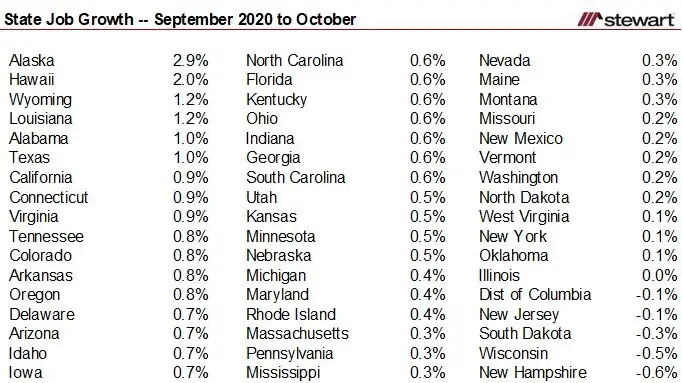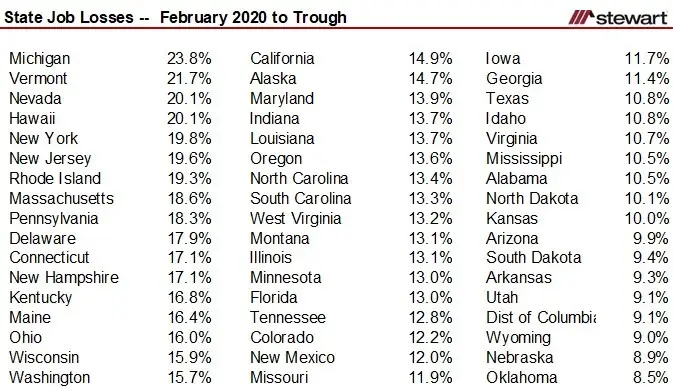State Employment October 2020 -- Still coming Back
Jobs are everything to the economy. Period.
The U.S. lost 22+ million jobs from February (pre-pandemic) to the trough, which was April for the country as a whole. Good news is jobs are continuing to come back. Bad news is there are still 10 million jobs missing as of October compared to February of this year. All employment data discussed in this blog are sourced from the U.S. Bureau of Labor Statistics (BLS) using seasonally adjusted data.
The first table shows job growth rates for just one month, from September to October 2020. Top one-month job growth was in Alaska (+2.9 percent) and Hawaii (+2.0 percent). Both of these states had restricted access (Alaska requiring a negative COVID test and Hawaii 14 days of quarantine) and are just now reawakening economically. Four states (New Jersey, South Dakota, Wisconsin and New Hampshire) and the District of Columbia posted a one-month job loss and just one state, Illinois, showed no change.

Job loss rates for the 12-months ending October 2020 are shown in the next table. Idaho is the lone state that, as of October 2020, had the same number of jobs compared to one-year ago. Utah is down less than 1 percent (-0.6 percent). Hawaii is the job-loss leader down 17.3 percent (almost 1-in-6 jobs missing) with New York placing second down 10.4 percent (short 1-in-10).

The pandemic’s severity of impact on jobs in each state are shown in the next table. The percentage of jobs lost from February to the trough are detailed, which was April for 49 of the states and May for the District of Columbia and Hawaii.

More important than jobs lost is the mass of jobs since recovered. Total percentage of lost-jobs (February 2020 to the trough) now recovered (from the trough to October 2020) are shown in the next table. The range of recovery is massive, from a low of 12.8 percent of lost jobs (just 1-in-8) brought back in Hawaii to a high of 89.7 percent (9-in-10) in Idaho.

The last table shows all of the prior metrics by state (and the District of Columbia) plus total employment numbers as of October 2020.

While there are multiple vaccines soon to be available in the coming quarters, COVID infection rates continue to spiral. Much of the unemployment assistance under the CARES Act that has not already timed-out expires in the last week of December. Uncertain is whether Congress will pass any further stimulus funding prior to year-end. Where employment is headed thus remains unknown. The only certainty is that the incidence of economic impact of the pandemic and recovery rates varies significantly across the country.
Ted
